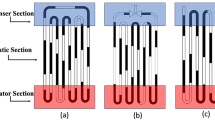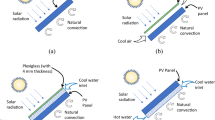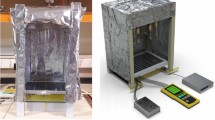Abstract
In this paper, the thermal performance of wavy finned solar air heater are investigated experimentally. Experiments were performed under Jamshedpur (22° 48’ N, 86° 11′ E) prevailing weather conditions. The effect of mass flow rate, fin spacing and insolation on thermal efficiency and air temperature rise of wavy fin solar air heaters are investigated. The results showed that the maximum efficiency of 69.55% has been found for the mass flow rate 0.0158 kg/s and fin spacing of 2 cm. Further, for the same fin spacing, maximum air temperature rise has been obtained as 64.33°C at the mass flow rate of 0.00312 kg/s. For the range of mass flow rate (0.00312–0.0158 kg/s) and fin spacing (2–6 cm), the wavy fin absorber solar air heater has been found to be 67.44 to 121.43% thermally efficient. These experimental results would be reliable and useful for optimum design in practical applications.

















Similar content being viewed by others
Abbreviations
- \( \overline{h} \) :
-
Heat transfer coefficient (W/m2 -K)
- Ac :
-
Collector area (m2)
- F′:
-
Collector efficiency factor
- FR :
-
Collector heat removal factor
- I:
-
Insolation (W/m2)
- Ti :
-
Inlet air temperature (K)
- Tpm :
-
Mean temperature of absorber plate(K)
- η:
-
Thermal efficiency
- (τα):
-
Transmittance absorptance product
- ΔT:
-
Rise in temperature (K)
- To :
-
Outlet air temperature (K)
- \( \dot{m} \) :
-
Mass flow rate of air (kg/s)
- A:
-
Total heat transfer area (m2)
- Cp :
-
Specific heat of air (J/kg-K)
- Tfm :
-
Mean temperature of air (K)
- Cd :
-
Coefficient of discharge
- \( \overline{h}A \) :
-
Thermal conductance (W/K)
- UL :
-
Total loss coefficient (W/m2 -K)
References
Sukhatme SP, Nayak JK (1996) Principles of Thermal Collection and Storage, 2nd edn. Tata Mc Graw Hill Education, New Delhi
Duffie JA, Beckman WA (1980) Solar Engineering of Thermal Processes. Wiley, New York
Xiao L, Wu S-Y, Zhang Q-L, Li Y-R (2012) Theoretical investigation on thermal performance of heat pipe flat plate solar collector with cross flow heat exchanger. Heat Mass Transf 48(7):1167–1176
Hesselgreaves JE (2001) Compact Heat Exchangers: Selection, Design and Operation. Elsevier Science Pvt. Ltd., Cambridge
Junqi D, Chen J, Chen Z, Zhou Y, Wenfeng Z (2007) Heat transfer and pressure drop correlations for the wavy fin and flat tube heat exchangers. Appl Therm Eng 27(11–12):2066–2073
Snyder B, Li KT, Wirtz RA (1993) Heat Transfer Enhancement in a Serpentine Channel. Int J Heat Mass Transf 36:2965–2976
Kays WM, London AL (1984) Compact Heat Exchangers, 3rd edn. McGrawHill, New York
Garg VK, Maji PK (1988) Flow and Heat Transfer in a Sinusoidally Curved Channel. International Journal of Engineering Fluid Mechanics 1:293–319
Nishimura T, Kajimoto Y, Tarumoto A, Kawamura Y (1986) Flow Structure and Mass Transfer For a Wavy Channel in Transitional Flow Regime. J Chem Eng Jpn 19:449–455
Nishimura T, Yoshino T, Kawamura Y (1987) Instability of Flow in a Sinusoidal Wavy Channel With Narrow Spacing. J Chem Eng Jpn 20:102–104
Oyakawa K, Shinzato T, Mabuchi I (1989) The Effects of the Channel Width on Heat-Transfer Augmentation in a Sinusoidal Wave Channel. JSME Int J 32:403–410
Asako Y, Nakamura H, Faghri M (1988) Heat Transfer and pressure drop characteristics in a corrugated duct with rounded corners. International Journal of Heat Transfer 31:1237–1245
Priyam A, Chand P (2016) Thermal and thermohydraulic performanceof wavy finned absorber solar air heater. Sol Energy 130:250–259
Priyam A, Chand P (2018) Effect of wavelength and amplitude on the performance of wavy finned absorber solar air heater. Renew Energy 119:690–702
Priyam, A. Chand, P.2016. Effect of collector aspect ratio on the thermal performance of wavy finned absorber solar air heater. Energy and Power Engineering. 10(5). 562–566. waset.org
ASHRAE standard 93-77 (ANSI B 1981-1977) (1977) Methods of Testing to Determine the Thermal Performance of Solar Collectors. ASHRAE, New York
Kline SJ, McClintock FA (1953) Describing Uncertainties in Single Sample Experiments. Mech Eng 75:3–8
Shewen EC, Hollands KGT (1979) Equations for presenting the Ut- dependence in collector test procedures. Proceedings of Int. Solar Energy Society, Atlanta, pp 360–364
Whiller A (1967) Design factors influencing solar collector performance. In: Jordan RC (ed) Low Temperature Engineering Applications of Solar Energy. ASHRAE, New York, p 27
Karim MA, Hawlader MNA (2006) Performance investigation of flat, v- corrugated and finned air collectors. Energy 31:452–470
Author information
Authors and Affiliations
Corresponding author
Additional information
Publisher’s note
Springer Nature remains neutral with regard to jurisdictional claims in published maps and institutional affiliations.
Appendices
Appendix 1: Error analysis
Although extreme care has been taken to perform experiment but there is always a chance of error in experimental measurements. So, it is necessary to determine maximum possible error in the experimental measurements. The error analysis was done for the error interval associated with experimental results. The methodology suggested by cline and Mc clintock [19] has been used to measure the error.
If the value of any parameter is calculated using certain measured quantities then error in measurement of ‘φ’ (parameters) is given as:
Where δx1, δx2, δx3......δxn are the possible errors in measurements x1, x2, x3....xn andδφ is called as absolute uncertainty and δφ/φ is known as relative uncertainty. Table 6 shows the accuracy of measuring instruments.
Area of absorber plate
Area of Flow
Area of orifice meter (A o)
Mass flow rate (\( \dot{m} \))
Useful heat gain (Qu)
Heat transfer coefficient ( \( \overline{h} \) )
Rights and permissions
About this article
Cite this article
Priyam, A., Chand, P. Experimental investigations on thermal performance of solar air heater with wavy fin absorbers. Heat Mass Transfer 55, 2651–2666 (2019). https://doi.org/10.1007/s00231-019-02605-1
Received:
Accepted:
Published:
Issue Date:
DOI: https://doi.org/10.1007/s00231-019-02605-1




